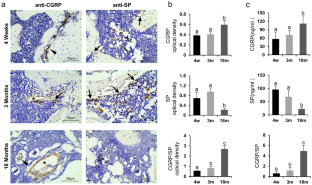The ratio of alpha-calcitonin gene-related peptide to substance P is associated with the transition of bone metabolic states during aging and healing
Abstract
Alpha-calcitonin gene-related peptide (αCGRP) and substance P (SP) are functionally correlated sensory neuropeptides deeply involved in bone homeostasis. However, they are usually studied individually rather than as an organic whole. To figure out whether they are interdependent, we firstly recorded the real-time αCGRP and SP levels in aging bone and healing fracture, which revealed a moderate to high level of αCGRP coupled with a low αCGRP/SP ratio in an anabolic state, and a high level of αCGRP coupled with a high αCGRP/SP ratio in a catabolic state, suggesting the importance of αCGRP/SP ratio in driving aging and healing scenarios. During facture healing, increase in αCGRP/SP ratio by adding αCGRP led to better callus formation and faster callus remodeling, while simultaneous addition of αCGRP and SP resulted in hypertrophic callus and delayed remodeling. The characteristics in inflammation and osteoclast activation further confirmed the importance of high αCGRP/SP ratio during catabolic bone remodeling. In vitro assays using different mixtures of αCGRP-SP proved that the osteogenic potential of the mixtures depended mostly on αCGRP, while their effects on osteoclasts and neutrophils relied on both peptides. These results demonstrated that αCGRP and SP were spatiotemporally interdependent. The αCGRP/SP ratio may be more important than the dose of a single neuropeptide in managing age-related and trauma-related bone diseases.


 求助内容:
求助内容: 应助结果提醒方式:
应助结果提醒方式:


